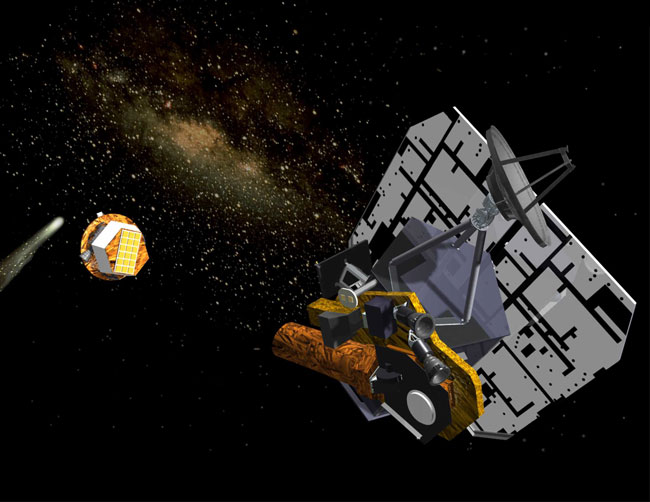Deep Impact Flyby Spacecraft Ready For New Mission

BOULDER, Colorado - Following its smashing success earlier this month with comet Tempel 1, the Deep Impact Flyby spacecraft is being readied for potential retargeting to yet another scientific destination.
The two-part Deep Impact craft consisted of the destroyed-on-purpose, battery-powered Impactor probe that was literally run over by Tempel 1, and a still-healthy Flyby spacecraft that monitored the event from a safe distance.
"NASA has given us a tiny amount of funding to make a maneuver next week that will set up the right trajectory and then enough money to keep the spacecraft alive in safe mode," said Michael A'Hearn, an astronomer at the University of Maryland in College Park, Maryland. He is the Deep Impact mission's principal investigator.
"They have not approved the extended mission yet because they haven't found the money," A'Hearn told SPACE.com, noting that comet 85P/Boethin is the target for a hoped for new science objective.
This new object of desire, comet 85P/Boethin, was spotted in 1975 during a comet-sweeping session carried out by the now deceased Reverend Leo Boethin of the Philippines.
The comet experienced two close approaches to Jupiter during the 20th century. It will make two close approaches to Earth and two close approaches to Jupiter during the first half of the 21st century, based on the orbital work of Japanese astronomer, Kazuo Kinoshita.
Healthy spacecraft
Breaking space news, the latest updates on rocket launches, skywatching events and more!
The dual-element Deep Impact spacecraft was designed and built here by Ball Aerospace & Technologies Corporation.
NASA's $333 million Deep Impact mission is a Discovery-class project, one of a pedigree of probes that achieve ground-breaking, highly-focused science within strict cost and schedule limitations.
The encounter with Tempel 1 occurred nearly 83 million miles from Earth and at closing speeds approaching 23,000 miles per hour. The Impactor on July 4 at 1:52 a.m. EDT (0552 GMT) exhumed material from Tempel 1's nucleus - the central portion of the head of a comet.
After imaging the encounter and sailing through the tail of the departing comet in a protected shield mode, the Flyby spacecraft -- outfitted with science instruments and carrying a healthy reserve of fuel -- continues to perform flawlessly.
Engineers did expect some damage to the Flyby spacecraft as a result of sweeping through Tempel 1's coma and tail, but after exiting shield mode and starting the look-back imagery, they discovered "no appreciable damage," said Monte Henderson, Deputy Director of Programs in Civil Space Systems for Ball Aerospace.
The spacecraft's optics has shown no sign of sandblasting, he told SPACE.com, with the vehicle's high-gain antenna also in excellent shape. Not a single solar cell on the solar arrays was lost, he added. "We couldn't be happier."
Green light for maneuver
NASA Headquarters in Washington, D.C. has given Deep Impact project leaders the green light to perform a maneuver later this month to bring the spacecraft back to Earth in early 2008, said Donald Yeomans, Supervisor of the Solar System Dynamics Group at the Jet Propulsion Laboratory (JPL) in Pasadena, California.
Yeomans told SPACE.com that, presumably, the Deep Impact project would have to obtain extended mission funds via a new - and successful - Discovery proposal.
"Using an Earth swingby, the spacecraft could be re-targeted to comet 85P/Boethin in late 2008," Yeomans said. Cameras on-board the Flyby spacecraft have shown their abilities to provide impressive imaging. Additionally, the infrared spectrometer has also performed beautifully, he said.
Scientists are delighted given the bang-up findings from the Deep Impact earlier this month. In particular, experts can now compare and contrast observations between several comets.
One minor concern
"To my mind, one of the key results of the Deep Impact mission is that there are major differences between the nuclei of Halley, Borrelly, Wild 2 and Tempel 1," Yeomans noted. "Tempel 1, at least, does not seem to conform to the 'fresh surface -- no impact craters -- crusted over dirty iceball model' that seemed so popular prior to Deep Impact."
That being the case, Yeomans added, the more cometary nuclei that can be studied at high resolution the better. "Comet Boethin is one of the most accessible periodic comets for the Deep Impact spacecraft and with the shortest flight time," he said.
But there is one minor concern about Boethin, Yeoman explained. It has only been seen in 1975 and 1986. It was missed at its 1997 return to the Sun, he said, because it was on the other side of the Sun from Earth at the time.
"I'd be a bit more comfortable if one of our large aperture telescopes could recover the comet this year or next...prior to its return to perihelion [closest approach to the Sun] in 2008," Yeomans concluded.
- Deep Impact: Viewer's Guide and Mission News

Leonard David is an award-winning space journalist who has been reporting on space activities for more than 50 years. Currently writing as Space.com's Space Insider Columnist among his other projects, Leonard has authored numerous books on space exploration, Mars missions and more, with his latest being "Moon Rush: The New Space Race" published in 2019 by National Geographic. He also wrote "Mars: Our Future on the Red Planet" released in 2016 by National Geographic. Leonard has served as a correspondent for SpaceNews, Scientific American and Aerospace America for the AIAA. He has received many awards, including the first Ordway Award for Sustained Excellence in Spaceflight History in 2015 at the AAS Wernher von Braun Memorial Symposium. You can find out Leonard's latest project at his website and on Twitter.
